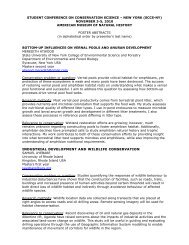SRMP Dynamic Earth Curriculum - American Museum of Natural ...
SRMP Dynamic Earth Curriculum - American Museum of Natural ...
SRMP Dynamic Earth Curriculum - American Museum of Natural ...
You also want an ePaper? Increase the reach of your titles
YUMPU automatically turns print PDFs into web optimized ePapers that Google loves.
Science Research Mentoring Program<strong>Dynamic</strong> <strong>Earth</strong>Session Four: Rock CycleACTIVITY: Thin SectionsBefore class: Set up 5-10 microscopes. At each microscope put one thin section <strong>of</strong> particular rocktype (more if available). If thin sections are not available, view images <strong>of</strong> thin sections that can befound online.During class: Briefly explain how thin sections are made. Tell students that the slide(s) at eachmicroscope shows a different rock. Instruct student to move to each microscope in turn, viewthin section(s), and record the key features in their notebooks. Based on these features, studentsdetermine what type <strong>of</strong> rock is at each microscope.Once students have viewed all <strong>of</strong> the thin sections and determined rock types, discuss their answersas a class.ACTIVITY: Rock Outcrops in Central ParkBefore class: Investigate rock outcrops in Central Park. Pick two or more that show a variety <strong>of</strong> rocktypes or features. If Central Park is not available, look for other rock outcrops near the classroom, ortake pictures <strong>of</strong> local rock outcrops and project them on a screen.During class: Explain that geologists have to identify rocks in the field. In this activity, students willhave a chance to identify rocks in situ and note their features. These will allow them to reconstructthe history <strong>of</strong> the rock.Take students to an outcrop and hand out magnifying lenses and worksheets. Ask students toobserve the rock and record their observations for Outcrop 1 on the worksheet. Students thenshare what they see with the class. Point out and further discuss any features that they missed ormisinterpreted.Move to a second outcrop. Ask students to observe the rock and record their observations again,this time searching for items on the scavenger hunt. Students follow directions on the worksheet,looking for the features listed, then reconstructing the history <strong>of</strong> the rock. After students havecompleted the reconstruction, discuses as a class.If time allows, observe additional outcrops.© 2013 <strong>American</strong> <strong>Museum</strong> <strong>of</strong> <strong>Natural</strong> History. All Rights Reserved. 21
















